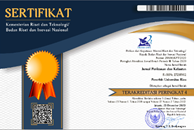The Effect of Probiotics on Bacillus sp Population, Water Quality, and Growth Rate of Striped Catfish (Pangasianodon hypophthalmus) in Pounds without Water Change
(1) Department of Fisheries Extension, Jakarta Technical University of Fisheries
(2) Department of Fisheries Extension, Jakarta Technical University of Fisheries
(3) Department of Fisheries Extension, Jakarta Technical University of Fisheries
(*) Corresponding Author
Abstract
Keywords
Full Text:
PDFReferences
AOAC. 2005. Association of Officiating Analytical Chemists (18th ed.). AOAC.
APHA. 2017. Standard Methods for the Examination of Water and Wastewater (E. W. Rice, R. B. Baird, & A. D. Eaton (eds.); 23rd ed.). AWWA (American Water Works Association).
Arfiati, D., Lailiyah, S., Dina, K.H dan Cokrowati, N. 2020. Dinamika jumlah bakteri Bacillus subtilis dalam penurunan kadar bahan organik TOM limbah budidaya ikan lele sangkuriang (Claris gariepinus). JFMR Journal of Fisheries and Marine Reseach, 4 (2): 222-226.
Beauty, G., Yustiati, A., Grandiosa, R. 2012. Pengaruh dosis mikroorganisme probiotik pada media pemeliharaan terhadap kelangsungan hidup dan pertumbuhan benih mas koki (Carasius auratus) dengan padat penebaran berbeda. Jurnal Perikanan Kelautan 3(3).
Budianto, B; Suprayanti, H. 2017. Aktivitas antagonis Bacillus subtilis terhadap Streptococcus iniae dan Pseudomonas fluorencens. J Veteriner 18, 409-415.
Gabriela, M; Ferrira, P; Melo F. P; Paulo, J; Lima V, Andrade, H.A. 2017. Bioremediation and biocontrol of commercial probiotic in marine shrimp culture with biofloc. Latin American Journal of Aquaculture research, 45 (10): 176-176.
Khademzade, O., Zakeri, M., Haghi, M dan Mousavi, S. M. 2020. The effect of water additivee Bacillus cereus and Pediococcus acidilactici on water quality, growth performances, economic benefits, immunohematology and bacterial flora of whiteleg shrimp (Penaeus nannamei Boone, 19310 reared in earthe ponds. Aquaculture Research, 51(5): 1759-1770.
Lukwambe, B., Qiuqian, L., Wu, J., Zhang, D., Wamg, K dan Zheng, Z. 2015. The effects of commercial microbial agents (probiotics) on phytoplankton community structure in intensive white shrimp (Litopenaeus vannamei) aquaculture pond. Aquaculture International, 23 (6): 1443-1455.
Padmavthi, P., Sunitha, K; dan Veeraiah, K. 2012.. Efficacy of probiotics in improving water quality and bacterial flora in fish pond. African Journal of Micrpbiology Research, 6 (49): 7471-7478.
Pant, B., Lohani, V., Mishra, Trakroo, M.D dan Tewari , H. 2019. Effect of probiotic upplementation on growth of carp fingerlings. National Academy Science Letters 42 (3): 215-220.
Pratama, W.D dan Manan, A. 2017. Pengaruh pemberian probiotik berbeda dalam sistem akuaponik terhadap kualitas air pada budidaya ikan lele (Clarias sp). Journal of Aquaculture Science, 1(1): 27-35.
Rachmawati, D., Samidjan, I dan Setyono, H. Manajamen Kualitas Media Budidaya Ikan Lele Sangkuring (Claris gariepinus) dengan Teknik Probiotik pada Kolam Terpal di Dea Vokasi Reksosari, Kecamatan Suruh. Jurnal Ilmiah Perikanan dan Kelautan, 12 (1).
Sukoco, F, A., Rahardja, B.S., Manan, A. 2017. Pengaruh pemberian probiotik berbeda dalam sistem akuaponik terhadap FCR (feed conversion ratio) dan biomassa ikan lele (Clarias sp). Journal of Aquaculture and Fish Health 6 (1) 24-31.
Takaichi, S. 2011. Carotenoid in algae: Distribution, Biosynthesis and Functions,. Mar. Drug 9,1101-1118, https://doi.org/10.3390/md9061101.
Zheng, X., Tang, J., Ren, G., Wang, Y. 2017. The effect of four microbial product on production performance and water quality in intergrated culture of freshwater pearl mussel and fishes. Aquaculture Research 48 (9): 4897-4909.
Article Metrics
Abstract view : 284 timesPDF - 468 times
DOI: http://dx.doi.org/10.31258/jpk.27.1.32-36
Copyright (c) 2022 Jurnal Perikanan dan Kelautan

This work is licensed under a Creative Commons Attribution-NonCommercial-NoDerivatives 4.0 International License.
Gedung Marine Center Lt 2. Fakultas Perikanan dan Kelautan Universitas Riau



